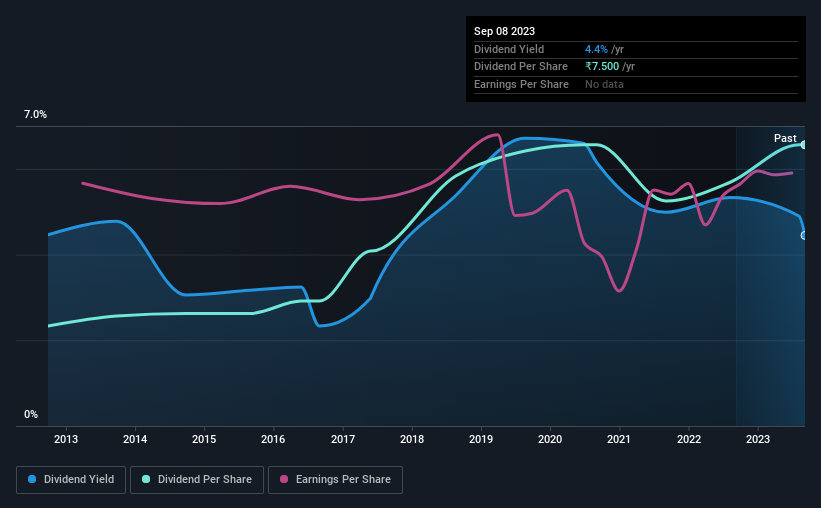- India
- /
- Industrials
- /
- NSEI:BALMLAWRIE
Balmer Lawrie (NSE:BALMLAWRIE) Will Pay A Larger Dividend Than Last Year At ₹7.50

Balmer Lawrie & Co. Ltd. (NSE:BALMLAWRIE) has announced that it will be increasing its dividend from last year's comparable payment on the 27th of October to ₹7.50. This will take the dividend yield to an attractive 4.4%, providing a nice boost to shareholder returns.
Check out our latest analysis for Balmer Lawrie
Balmer Lawrie's Earnings Easily Cover The Distributions
If the payments aren't sustainable, a high yield for a few years won't matter that much. Prior to this announcement, Balmer Lawrie was paying out 75% of earnings and more than 75% of free cash flows. This indicates that the company is more focused on returning cash to shareholders than growing the business, but we don't think that there are necessarily signs that the dividend might be unsustainable.
EPS is set to grow by 0.9% over the next year if recent trends continue. Assuming the dividend continues along recent trends, our estimates say the payout ratio could reach 81%, which is definitely on the higher side, but we wouldn't necessarily say this is unsustainable.

Dividend Volatility
While the company has been paying a dividend for a long time, it has cut the dividend at least once in the last 10 years. The annual payment during the last 10 years was ₹2.67 in 2013, and the most recent fiscal year payment was ₹7.50. This works out to be a compound annual growth rate (CAGR) of approximately 11% a year over that time. It is great to see strong growth in the dividend payments, but cuts are concerning as it may indicate the payout policy is too ambitious.
Dividend Growth May Be Hard To Achieve
Growing earnings per share could be a mitigating factor when considering the past fluctuations in the dividend. Unfortunately, Balmer Lawrie's earnings per share has been essentially flat over the past five years, which means the dividend may not be increased each year. There are exceptions, but limited earnings growth and a high payout ratio can signal that a company has reached maturity. When the rate of return on reinvestment opportunities falls below a certain minimum level, companies often elect to pay a larger dividend instead. This is why many mature companies often have larger dividend yields.
Our Thoughts On Balmer Lawrie's Dividend
Overall, we always like to see the dividend being raised, but we don't think Balmer Lawrie will make a great income stock. The low payout ratio is a redeeming feature, but generally we are not too happy with the payments Balmer Lawrie has been making. This company is not in the top tier of income providing stocks.
It's important to note that companies having a consistent dividend policy will generate greater investor confidence than those having an erratic one. Still, investors need to consider a host of other factors, apart from dividend payments, when analysing a company. For example, we've picked out 1 warning sign for Balmer Lawrie that investors should know about before committing capital to this stock. Is Balmer Lawrie not quite the opportunity you were looking for? Why not check out our selection of top dividend stocks.
Valuation is complex, but we're here to simplify it.
Discover if Balmer Lawrie might be undervalued or overvalued with our detailed analysis, featuring fair value estimates, potential risks, dividends, insider trades, and its financial condition.
Access Free AnalysisHave feedback on this article? Concerned about the content? Get in touch with us directly. Alternatively, email editorial-team (at) simplywallst.com.
This article by Simply Wall St is general in nature. We provide commentary based on historical data and analyst forecasts only using an unbiased methodology and our articles are not intended to be financial advice. It does not constitute a recommendation to buy or sell any stock, and does not take account of your objectives, or your financial situation. We aim to bring you long-term focused analysis driven by fundamental data. Note that our analysis may not factor in the latest price-sensitive company announcements or qualitative material. Simply Wall St has no position in any stocks mentioned.
About NSEI:BALMLAWRIE
Balmer Lawrie
Engages in industrial packaging, greases and lubricants, chemicals, logistic services and infrastructure, refinery and oil field, and travel and vacation services businesses in India and internationally.
Flawless balance sheet with proven track record and pays a dividend.
Similar Companies
Market Insights
Community Narratives



